Leadership and Management Theories and Development Programme: Bupa
VerifiedAdded on 2023/01/12
|17
|5105
|92
Essay
AI Summary
This essay delves into the concepts of leadership and management, differentiating between the roles of leaders and managers within organizations, particularly in the healthcare sector. It reviews various leadership and management theories, including behavioral and charismatic leadership, and applies them to a case study of Bupa, a global healthcare provider. The essay explores the similarities and differences between leadership and management, emphasizing the importance of motivating employees and achieving organizational goals. Furthermore, it analyzes a proposed leadership training and development program for Bupa, evaluating its structure, eligibility, and benefits for both the individual leaders and the organization. The analysis considers the diverse employee base of Bupa, highlighting the need for adaptable leadership styles to effectively manage a multicultural workforce. The essay concludes by emphasizing the significance of effective leadership and management in achieving organizational success and fostering a positive work environment.
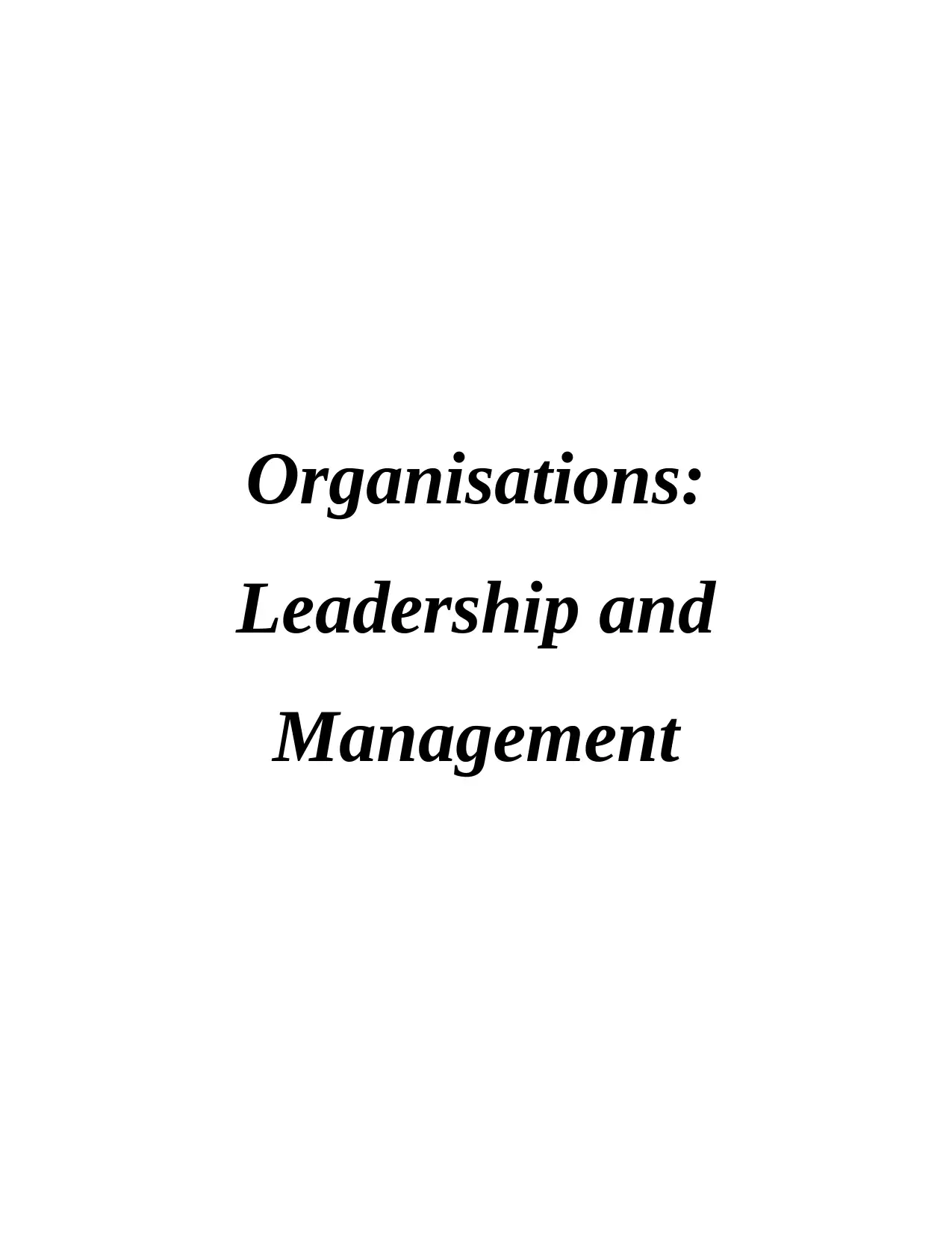
Organisations:
Leadership and
Management
Leadership and
Management
Paraphrase This Document
Need a fresh take? Get an instant paraphrase of this document with our AI Paraphraser
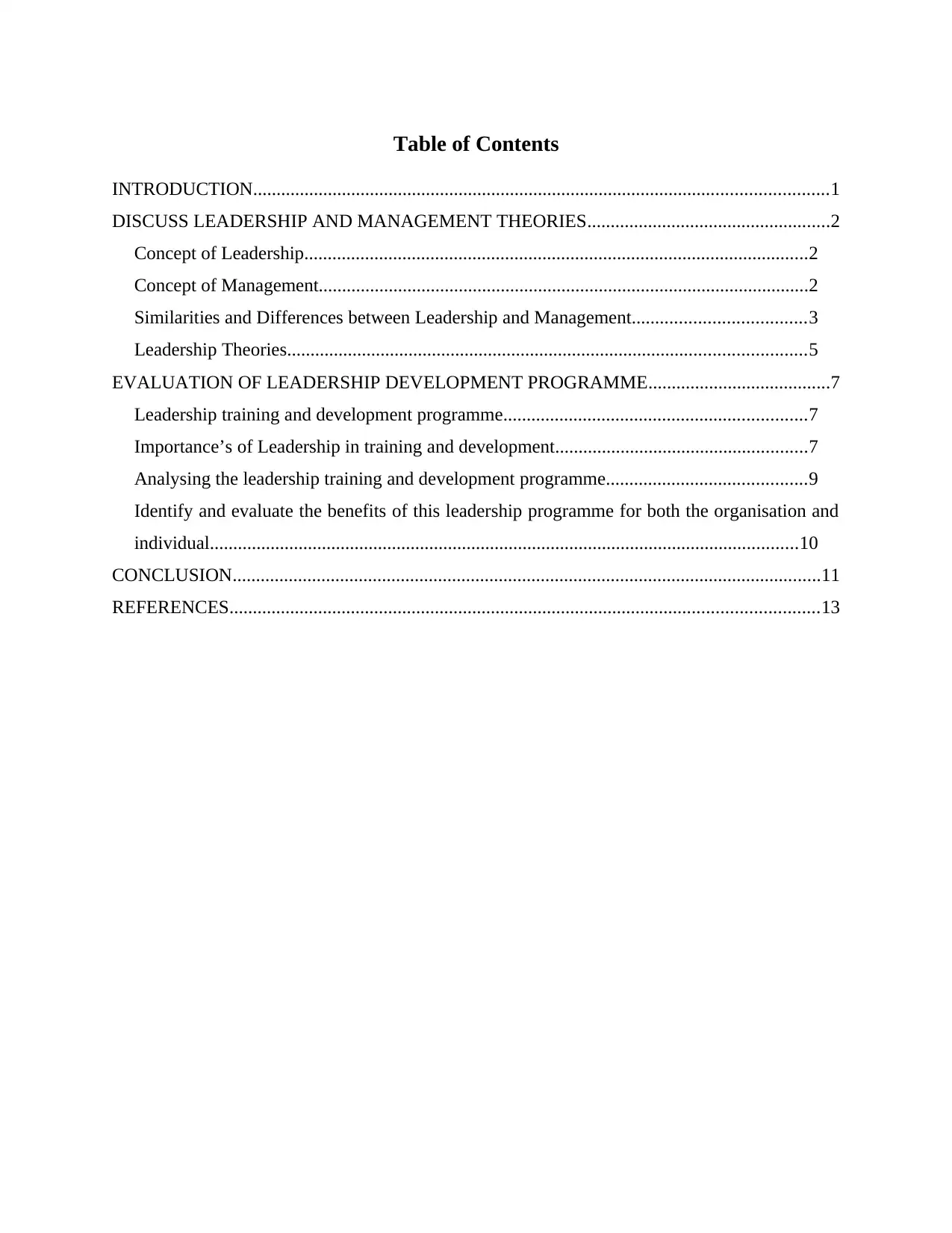
Table of Contents
INTRODUCTION...........................................................................................................................1
DISCUSS LEADERSHIP AND MANAGEMENT THEORIES....................................................2
Concept of Leadership............................................................................................................2
Concept of Management.........................................................................................................2
Similarities and Differences between Leadership and Management.....................................3
Leadership Theories...............................................................................................................5
EVALUATION OF LEADERSHIP DEVELOPMENT PROGRAMME.......................................7
Leadership training and development programme.................................................................7
Importance’s of Leadership in training and development......................................................7
Analysing the leadership training and development programme...........................................9
Identify and evaluate the benefits of this leadership programme for both the organisation and
individual..............................................................................................................................10
CONCLUSION..............................................................................................................................11
REFERENCES..............................................................................................................................13
INTRODUCTION...........................................................................................................................1
DISCUSS LEADERSHIP AND MANAGEMENT THEORIES....................................................2
Concept of Leadership............................................................................................................2
Concept of Management.........................................................................................................2
Similarities and Differences between Leadership and Management.....................................3
Leadership Theories...............................................................................................................5
EVALUATION OF LEADERSHIP DEVELOPMENT PROGRAMME.......................................7
Leadership training and development programme.................................................................7
Importance’s of Leadership in training and development......................................................7
Analysing the leadership training and development programme...........................................9
Identify and evaluate the benefits of this leadership programme for both the organisation and
individual..............................................................................................................................10
CONCLUSION..............................................................................................................................11
REFERENCES..............................................................................................................................13

⊘ This is a preview!⊘
Do you want full access?
Subscribe today to unlock all pages.

Trusted by 1+ million students worldwide

INTRODUCTION
Leadership and management are two separate concepts for which two different individuals are
responsible they are known as leaders and managers. A leader is the one who influences and
motivate the followers in order to perform in a particular manner for attaining certain
predetermined goes the personal or professional. Therefore leadership is known as the process of
motivating and encouraging the individual towards particular objectives by doing hard work in
order to increase the performance level and achieve objectives. Managers are the one who
manages the whole organisation and respective individuals working under them who are their
subordinates (Bush, Bell and Middlewood, 2019). Managers hold higher position than leaders in
an organisation as they are concerned with the whole company rather than just a team.
Management is the procedure or method of managing the whole organisation and the individuals
involved in it who are working on behalf of company for pertaining all organisational goals. the
number of Management and leadership theories available and applicable in different
organisational context and situations. Managers and leaders play the respective roles in order to
make the organisation most effective running the operations smoothly.
The essay is based on the leadership and management literature review. In this essay the concept
of leadership and Management are reviewed with the help of different organisational theories of
leadership and Management. At first leadership and Management concepts are described along
with their similarities and differences. Moving further two different leadership theories are
thoroughly evaluated and described along with application of one of the theory in organisational
context. At the end one leadership training and development programme is suggested to the
leaders of the respective company. The program is evaluated thoroughly by showing its
eligibility and structure, also benefits of the program to the individual for the leader who is
applying for it along with their organisation is explained. A healthcare organisation named as
Bupa is selected for this literature review. Bupa is a British international health Care
provisioning and multi insurance group which is headquartered in UK and serving to around 32
million customers from 190 countries in the world. Bupa was founded in 1947 and now serving
in worldwide locations. Main products and services offered by Bupa are health insurance, care
homes, hospitals, dental clinics, health assessment and health at work services. Leadership and
management theories are evaluated for Bupa as it has huge employee base belonging to different
cultures, holding period experiences and backgrounds.
1
Leadership and management are two separate concepts for which two different individuals are
responsible they are known as leaders and managers. A leader is the one who influences and
motivate the followers in order to perform in a particular manner for attaining certain
predetermined goes the personal or professional. Therefore leadership is known as the process of
motivating and encouraging the individual towards particular objectives by doing hard work in
order to increase the performance level and achieve objectives. Managers are the one who
manages the whole organisation and respective individuals working under them who are their
subordinates (Bush, Bell and Middlewood, 2019). Managers hold higher position than leaders in
an organisation as they are concerned with the whole company rather than just a team.
Management is the procedure or method of managing the whole organisation and the individuals
involved in it who are working on behalf of company for pertaining all organisational goals. the
number of Management and leadership theories available and applicable in different
organisational context and situations. Managers and leaders play the respective roles in order to
make the organisation most effective running the operations smoothly.
The essay is based on the leadership and management literature review. In this essay the concept
of leadership and Management are reviewed with the help of different organisational theories of
leadership and Management. At first leadership and Management concepts are described along
with their similarities and differences. Moving further two different leadership theories are
thoroughly evaluated and described along with application of one of the theory in organisational
context. At the end one leadership training and development programme is suggested to the
leaders of the respective company. The program is evaluated thoroughly by showing its
eligibility and structure, also benefits of the program to the individual for the leader who is
applying for it along with their organisation is explained. A healthcare organisation named as
Bupa is selected for this literature review. Bupa is a British international health Care
provisioning and multi insurance group which is headquartered in UK and serving to around 32
million customers from 190 countries in the world. Bupa was founded in 1947 and now serving
in worldwide locations. Main products and services offered by Bupa are health insurance, care
homes, hospitals, dental clinics, health assessment and health at work services. Leadership and
management theories are evaluated for Bupa as it has huge employee base belonging to different
cultures, holding period experiences and backgrounds.
1
Paraphrase This Document
Need a fresh take? Get an instant paraphrase of this document with our AI Paraphraser
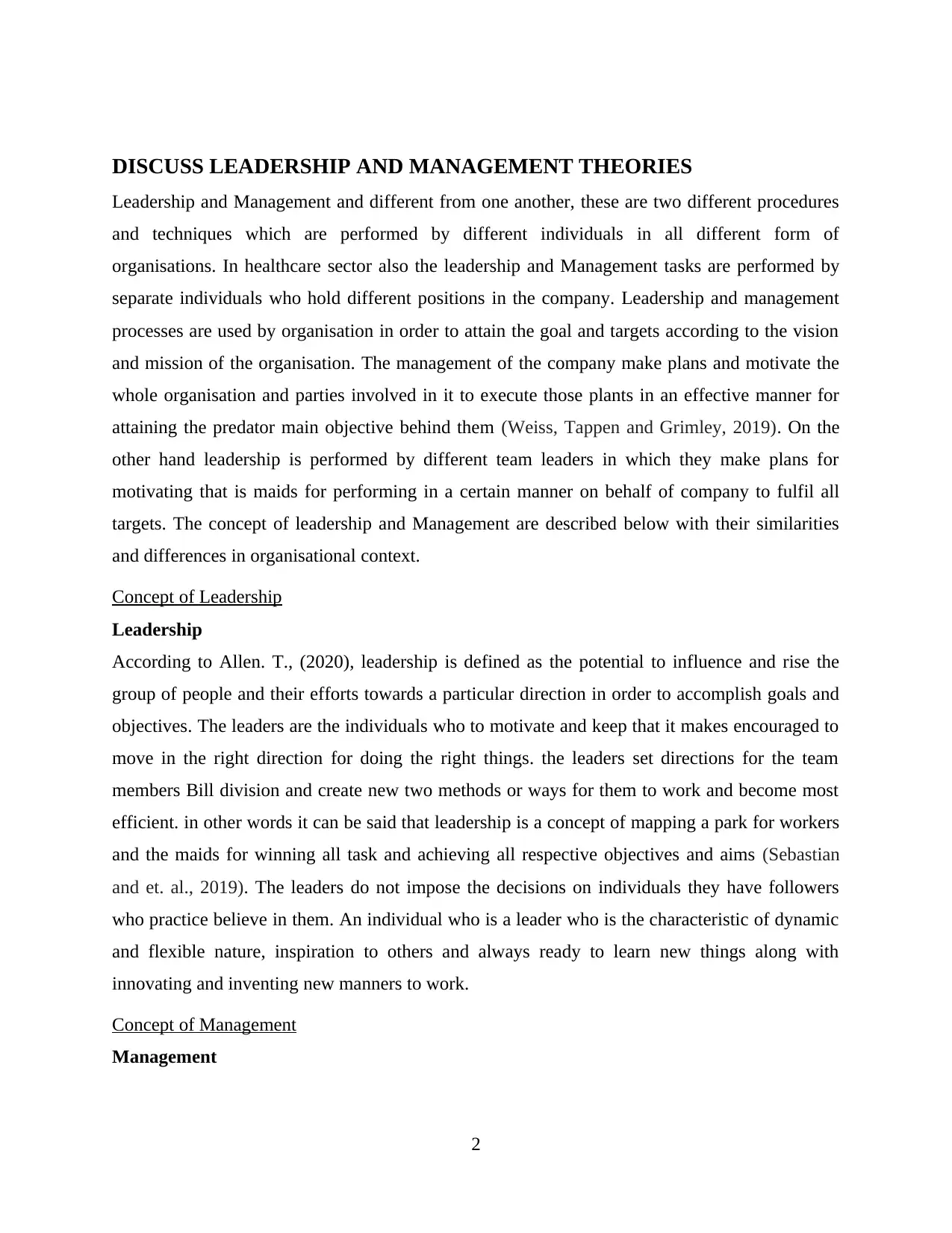
DISCUSS LEADERSHIP AND MANAGEMENT THEORIES
Leadership and Management and different from one another, these are two different procedures
and techniques which are performed by different individuals in all different form of
organisations. In healthcare sector also the leadership and Management tasks are performed by
separate individuals who hold different positions in the company. Leadership and management
processes are used by organisation in order to attain the goal and targets according to the vision
and mission of the organisation. The management of the company make plans and motivate the
whole organisation and parties involved in it to execute those plants in an effective manner for
attaining the predator main objective behind them (Weiss, Tappen and Grimley, 2019). On the
other hand leadership is performed by different team leaders in which they make plans for
motivating that is maids for performing in a certain manner on behalf of company to fulfil all
targets. The concept of leadership and Management are described below with their similarities
and differences in organisational context.
Concept of Leadership
Leadership
According to Allen. T., (2020), leadership is defined as the potential to influence and rise the
group of people and their efforts towards a particular direction in order to accomplish goals and
objectives. The leaders are the individuals who to motivate and keep that it makes encouraged to
move in the right direction for doing the right things. the leaders set directions for the team
members Bill division and create new two methods or ways for them to work and become most
efficient. in other words it can be said that leadership is a concept of mapping a park for workers
and the maids for winning all task and achieving all respective objectives and aims (Sebastian
and et. al., 2019). The leaders do not impose the decisions on individuals they have followers
who practice believe in them. An individual who is a leader who is the characteristic of dynamic
and flexible nature, inspiration to others and always ready to learn new things along with
innovating and inventing new manners to work.
Concept of Management
Management
2
Leadership and Management and different from one another, these are two different procedures
and techniques which are performed by different individuals in all different form of
organisations. In healthcare sector also the leadership and Management tasks are performed by
separate individuals who hold different positions in the company. Leadership and management
processes are used by organisation in order to attain the goal and targets according to the vision
and mission of the organisation. The management of the company make plans and motivate the
whole organisation and parties involved in it to execute those plants in an effective manner for
attaining the predator main objective behind them (Weiss, Tappen and Grimley, 2019). On the
other hand leadership is performed by different team leaders in which they make plans for
motivating that is maids for performing in a certain manner on behalf of company to fulfil all
targets. The concept of leadership and Management are described below with their similarities
and differences in organisational context.
Concept of Leadership
Leadership
According to Allen. T., (2020), leadership is defined as the potential to influence and rise the
group of people and their efforts towards a particular direction in order to accomplish goals and
objectives. The leaders are the individuals who to motivate and keep that it makes encouraged to
move in the right direction for doing the right things. the leaders set directions for the team
members Bill division and create new two methods or ways for them to work and become most
efficient. in other words it can be said that leadership is a concept of mapping a park for workers
and the maids for winning all task and achieving all respective objectives and aims (Sebastian
and et. al., 2019). The leaders do not impose the decisions on individuals they have followers
who practice believe in them. An individual who is a leader who is the characteristic of dynamic
and flexible nature, inspiration to others and always ready to learn new things along with
innovating and inventing new manners to work.
Concept of Management
Management
2
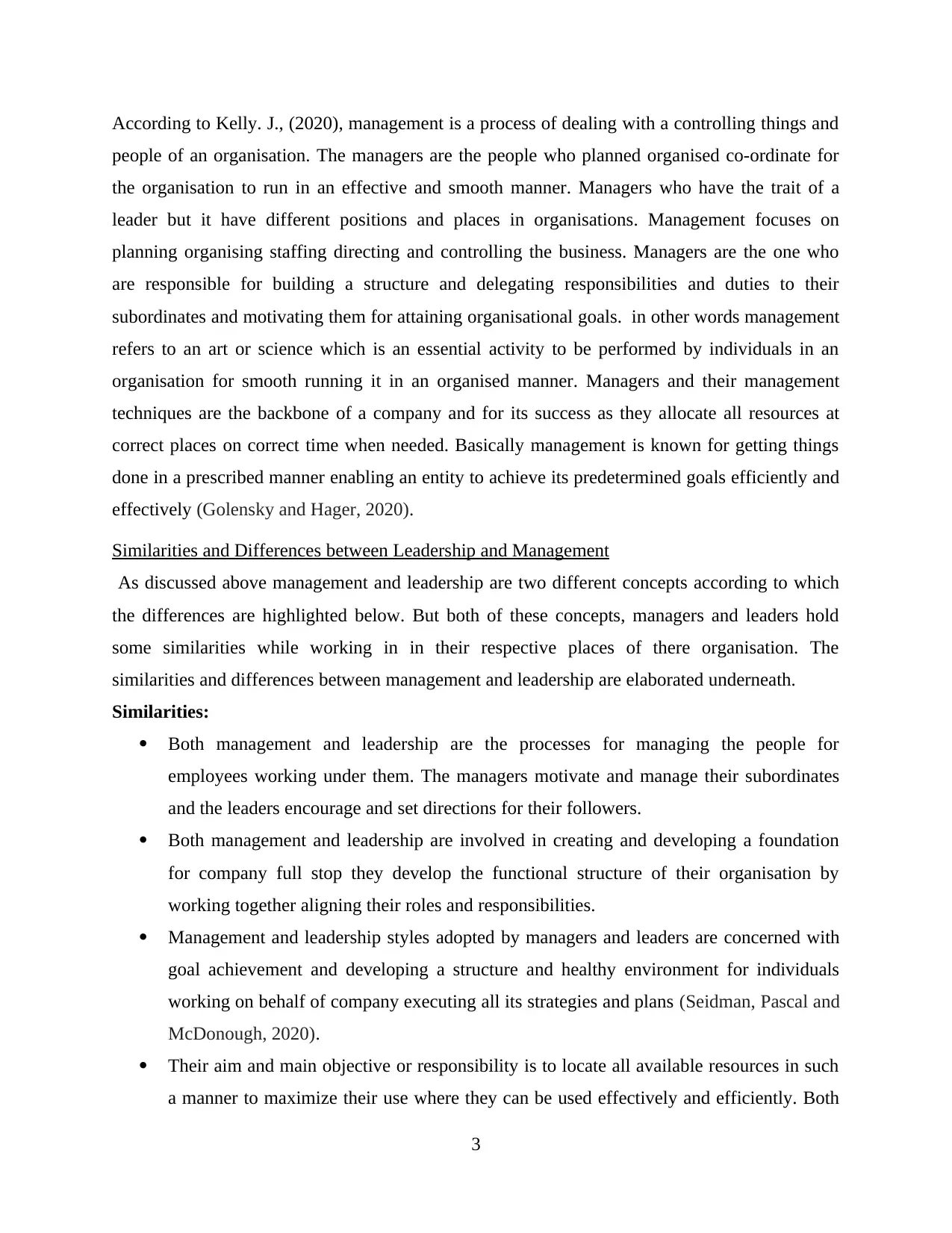
According to Kelly. J., (2020), management is a process of dealing with a controlling things and
people of an organisation. The managers are the people who planned organised co-ordinate for
the organisation to run in an effective and smooth manner. Managers who have the trait of a
leader but it have different positions and places in organisations. Management focuses on
planning organising staffing directing and controlling the business. Managers are the one who
are responsible for building a structure and delegating responsibilities and duties to their
subordinates and motivating them for attaining organisational goals. in other words management
refers to an art or science which is an essential activity to be performed by individuals in an
organisation for smooth running it in an organised manner. Managers and their management
techniques are the backbone of a company and for its success as they allocate all resources at
correct places on correct time when needed. Basically management is known for getting things
done in a prescribed manner enabling an entity to achieve its predetermined goals efficiently and
effectively (Golensky and Hager, 2020).
Similarities and Differences between Leadership and Management
As discussed above management and leadership are two different concepts according to which
the differences are highlighted below. But both of these concepts, managers and leaders hold
some similarities while working in in their respective places of there organisation. The
similarities and differences between management and leadership are elaborated underneath.
Similarities:
Both management and leadership are the processes for managing the people for
employees working under them. The managers motivate and manage their subordinates
and the leaders encourage and set directions for their followers.
Both management and leadership are involved in creating and developing a foundation
for company full stop they develop the functional structure of their organisation by
working together aligning their roles and responsibilities.
Management and leadership styles adopted by managers and leaders are concerned with
goal achievement and developing a structure and healthy environment for individuals
working on behalf of company executing all its strategies and plans (Seidman, Pascal and
McDonough, 2020).
Their aim and main objective or responsibility is to locate all available resources in such
a manner to maximize their use where they can be used effectively and efficiently. Both
3
people of an organisation. The managers are the people who planned organised co-ordinate for
the organisation to run in an effective and smooth manner. Managers who have the trait of a
leader but it have different positions and places in organisations. Management focuses on
planning organising staffing directing and controlling the business. Managers are the one who
are responsible for building a structure and delegating responsibilities and duties to their
subordinates and motivating them for attaining organisational goals. in other words management
refers to an art or science which is an essential activity to be performed by individuals in an
organisation for smooth running it in an organised manner. Managers and their management
techniques are the backbone of a company and for its success as they allocate all resources at
correct places on correct time when needed. Basically management is known for getting things
done in a prescribed manner enabling an entity to achieve its predetermined goals efficiently and
effectively (Golensky and Hager, 2020).
Similarities and Differences between Leadership and Management
As discussed above management and leadership are two different concepts according to which
the differences are highlighted below. But both of these concepts, managers and leaders hold
some similarities while working in in their respective places of there organisation. The
similarities and differences between management and leadership are elaborated underneath.
Similarities:
Both management and leadership are the processes for managing the people for
employees working under them. The managers motivate and manage their subordinates
and the leaders encourage and set directions for their followers.
Both management and leadership are involved in creating and developing a foundation
for company full stop they develop the functional structure of their organisation by
working together aligning their roles and responsibilities.
Management and leadership styles adopted by managers and leaders are concerned with
goal achievement and developing a structure and healthy environment for individuals
working on behalf of company executing all its strategies and plans (Seidman, Pascal and
McDonough, 2020).
Their aim and main objective or responsibility is to locate all available resources in such
a manner to maximize their use where they can be used effectively and efficiently. Both
3
⊘ This is a preview!⊘
Do you want full access?
Subscribe today to unlock all pages.

Trusted by 1+ million students worldwide
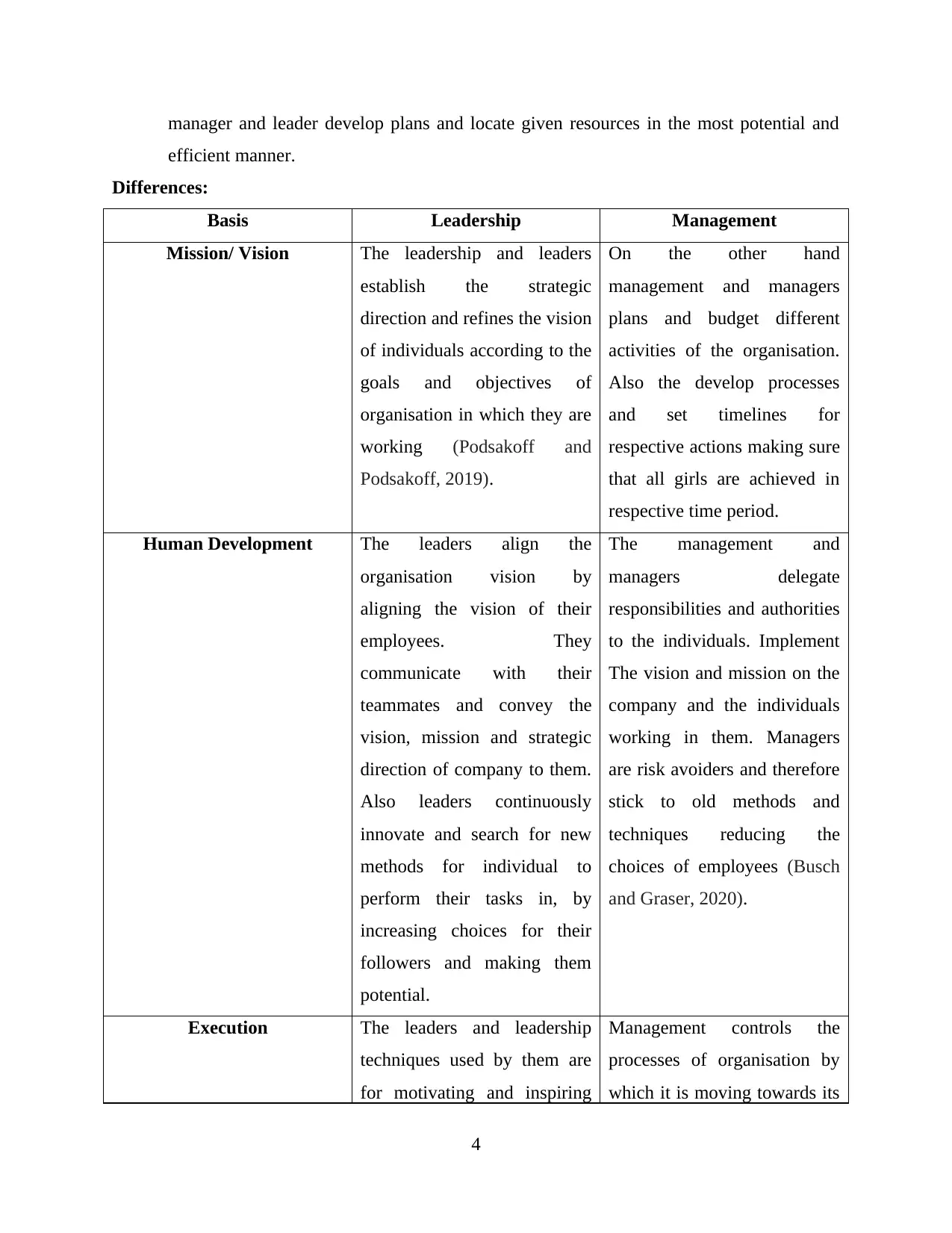
manager and leader develop plans and locate given resources in the most potential and
efficient manner.
Differences:
Basis Leadership Management
Mission/ Vision The leadership and leaders
establish the strategic
direction and refines the vision
of individuals according to the
goals and objectives of
organisation in which they are
working (Podsakoff and
Podsakoff, 2019).
On the other hand
management and managers
plans and budget different
activities of the organisation.
Also the develop processes
and set timelines for
respective actions making sure
that all girls are achieved in
respective time period.
Human Development The leaders align the
organisation vision by
aligning the vision of their
employees. They
communicate with their
teammates and convey the
vision, mission and strategic
direction of company to them.
Also leaders continuously
innovate and search for new
methods for individual to
perform their tasks in, by
increasing choices for their
followers and making them
potential.
The management and
managers delegate
responsibilities and authorities
to the individuals. Implement
The vision and mission on the
company and the individuals
working in them. Managers
are risk avoiders and therefore
stick to old methods and
techniques reducing the
choices of employees (Busch
and Graser, 2020).
Execution The leaders and leadership
techniques used by them are
for motivating and inspiring
Management controls the
processes of organisation by
which it is moving towards its
4
efficient manner.
Differences:
Basis Leadership Management
Mission/ Vision The leadership and leaders
establish the strategic
direction and refines the vision
of individuals according to the
goals and objectives of
organisation in which they are
working (Podsakoff and
Podsakoff, 2019).
On the other hand
management and managers
plans and budget different
activities of the organisation.
Also the develop processes
and set timelines for
respective actions making sure
that all girls are achieved in
respective time period.
Human Development The leaders align the
organisation vision by
aligning the vision of their
employees. They
communicate with their
teammates and convey the
vision, mission and strategic
direction of company to them.
Also leaders continuously
innovate and search for new
methods for individual to
perform their tasks in, by
increasing choices for their
followers and making them
potential.
The management and
managers delegate
responsibilities and authorities
to the individuals. Implement
The vision and mission on the
company and the individuals
working in them. Managers
are risk avoiders and therefore
stick to old methods and
techniques reducing the
choices of employees (Busch
and Graser, 2020).
Execution The leaders and leadership
techniques used by them are
for motivating and inspiring
Management controls the
processes of organisation by
which it is moving towards its
4
Paraphrase This Document
Need a fresh take? Get an instant paraphrase of this document with our AI Paraphraser
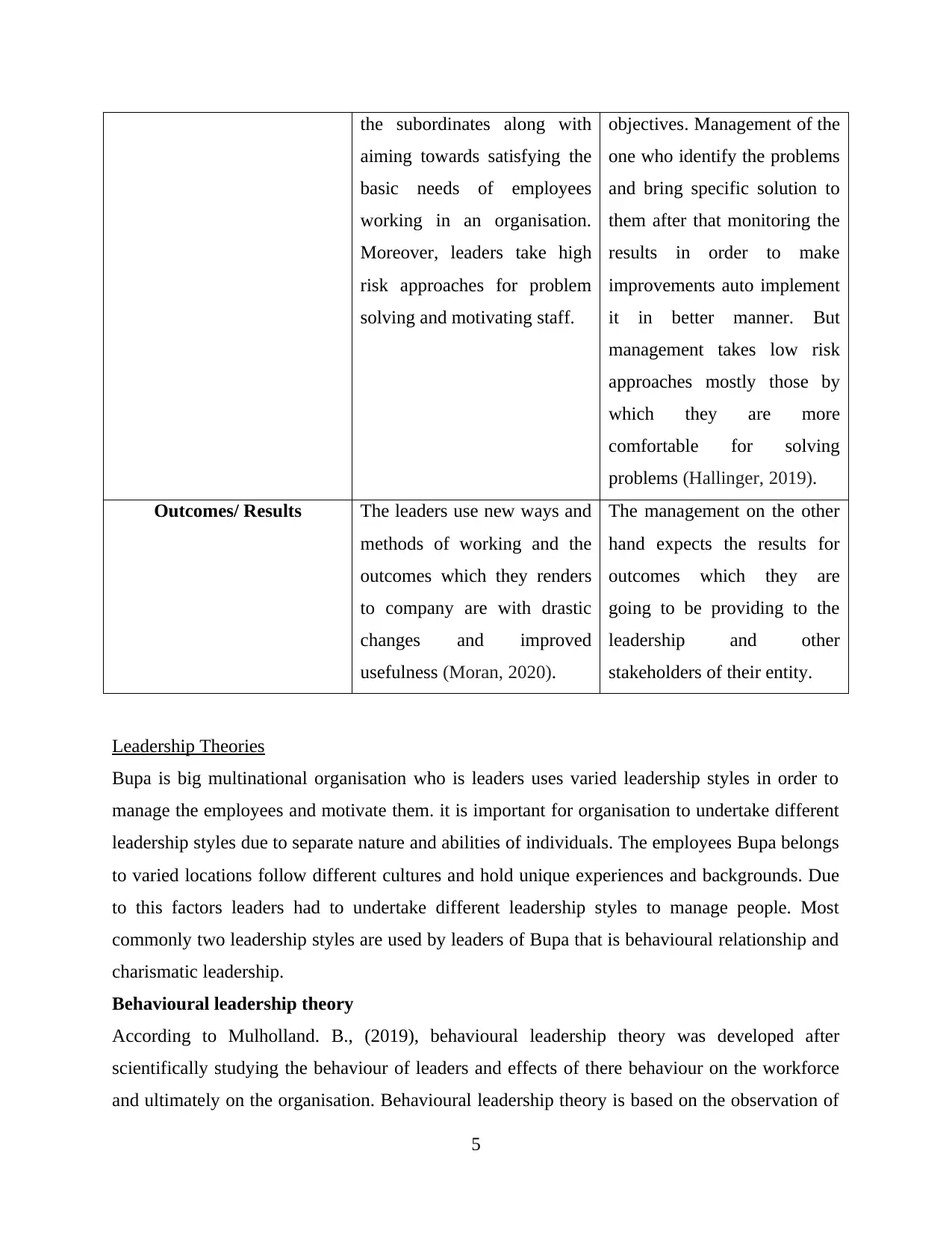
the subordinates along with
aiming towards satisfying the
basic needs of employees
working in an organisation.
Moreover, leaders take high
risk approaches for problem
solving and motivating staff.
objectives. Management of the
one who identify the problems
and bring specific solution to
them after that monitoring the
results in order to make
improvements auto implement
it in better manner. But
management takes low risk
approaches mostly those by
which they are more
comfortable for solving
problems (Hallinger, 2019).
Outcomes/ Results The leaders use new ways and
methods of working and the
outcomes which they renders
to company are with drastic
changes and improved
usefulness (Moran, 2020).
The management on the other
hand expects the results for
outcomes which they are
going to be providing to the
leadership and other
stakeholders of their entity.
Leadership Theories
Bupa is big multinational organisation who is leaders uses varied leadership styles in order to
manage the employees and motivate them. it is important for organisation to undertake different
leadership styles due to separate nature and abilities of individuals. The employees Bupa belongs
to varied locations follow different cultures and hold unique experiences and backgrounds. Due
to this factors leaders had to undertake different leadership styles to manage people. Most
commonly two leadership styles are used by leaders of Bupa that is behavioural relationship and
charismatic leadership.
Behavioural leadership theory
According to Mulholland. B., (2019), behavioural leadership theory was developed after
scientifically studying the behaviour of leaders and effects of there behaviour on the workforce
and ultimately on the organisation. Behavioural leadership theory is based on the observation of
5
aiming towards satisfying the
basic needs of employees
working in an organisation.
Moreover, leaders take high
risk approaches for problem
solving and motivating staff.
objectives. Management of the
one who identify the problems
and bring specific solution to
them after that monitoring the
results in order to make
improvements auto implement
it in better manner. But
management takes low risk
approaches mostly those by
which they are more
comfortable for solving
problems (Hallinger, 2019).
Outcomes/ Results The leaders use new ways and
methods of working and the
outcomes which they renders
to company are with drastic
changes and improved
usefulness (Moran, 2020).
The management on the other
hand expects the results for
outcomes which they are
going to be providing to the
leadership and other
stakeholders of their entity.
Leadership Theories
Bupa is big multinational organisation who is leaders uses varied leadership styles in order to
manage the employees and motivate them. it is important for organisation to undertake different
leadership styles due to separate nature and abilities of individuals. The employees Bupa belongs
to varied locations follow different cultures and hold unique experiences and backgrounds. Due
to this factors leaders had to undertake different leadership styles to manage people. Most
commonly two leadership styles are used by leaders of Bupa that is behavioural relationship and
charismatic leadership.
Behavioural leadership theory
According to Mulholland. B., (2019), behavioural leadership theory was developed after
scientifically studying the behaviour of leaders and effects of there behaviour on the workforce
and ultimately on the organisation. Behavioural leadership theory is based on the observation of
5
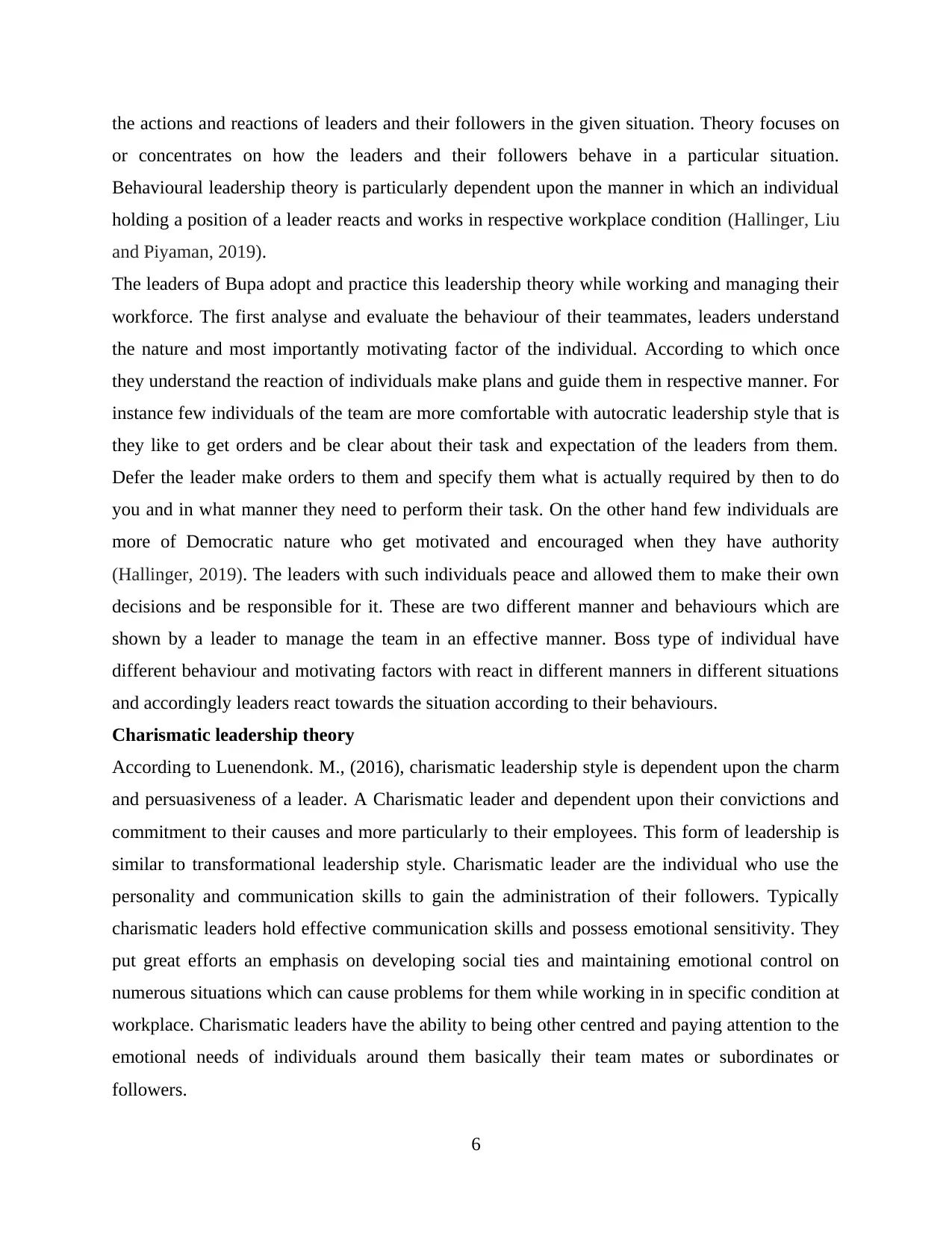
the actions and reactions of leaders and their followers in the given situation. Theory focuses on
or concentrates on how the leaders and their followers behave in a particular situation.
Behavioural leadership theory is particularly dependent upon the manner in which an individual
holding a position of a leader reacts and works in respective workplace condition (Hallinger, Liu
and Piyaman, 2019).
The leaders of Bupa adopt and practice this leadership theory while working and managing their
workforce. The first analyse and evaluate the behaviour of their teammates, leaders understand
the nature and most importantly motivating factor of the individual. According to which once
they understand the reaction of individuals make plans and guide them in respective manner. For
instance few individuals of the team are more comfortable with autocratic leadership style that is
they like to get orders and be clear about their task and expectation of the leaders from them.
Defer the leader make orders to them and specify them what is actually required by then to do
you and in what manner they need to perform their task. On the other hand few individuals are
more of Democratic nature who get motivated and encouraged when they have authority
(Hallinger, 2019). The leaders with such individuals peace and allowed them to make their own
decisions and be responsible for it. These are two different manner and behaviours which are
shown by a leader to manage the team in an effective manner. Boss type of individual have
different behaviour and motivating factors with react in different manners in different situations
and accordingly leaders react towards the situation according to their behaviours.
Charismatic leadership theory
According to Luenendonk. M., (2016), charismatic leadership style is dependent upon the charm
and persuasiveness of a leader. A Charismatic leader and dependent upon their convictions and
commitment to their causes and more particularly to their employees. This form of leadership is
similar to transformational leadership style. Charismatic leader are the individual who use the
personality and communication skills to gain the administration of their followers. Typically
charismatic leaders hold effective communication skills and possess emotional sensitivity. They
put great efforts an emphasis on developing social ties and maintaining emotional control on
numerous situations which can cause problems for them while working in in specific condition at
workplace. Charismatic leaders have the ability to being other centred and paying attention to the
emotional needs of individuals around them basically their team mates or subordinates or
followers.
6
or concentrates on how the leaders and their followers behave in a particular situation.
Behavioural leadership theory is particularly dependent upon the manner in which an individual
holding a position of a leader reacts and works in respective workplace condition (Hallinger, Liu
and Piyaman, 2019).
The leaders of Bupa adopt and practice this leadership theory while working and managing their
workforce. The first analyse and evaluate the behaviour of their teammates, leaders understand
the nature and most importantly motivating factor of the individual. According to which once
they understand the reaction of individuals make plans and guide them in respective manner. For
instance few individuals of the team are more comfortable with autocratic leadership style that is
they like to get orders and be clear about their task and expectation of the leaders from them.
Defer the leader make orders to them and specify them what is actually required by then to do
you and in what manner they need to perform their task. On the other hand few individuals are
more of Democratic nature who get motivated and encouraged when they have authority
(Hallinger, 2019). The leaders with such individuals peace and allowed them to make their own
decisions and be responsible for it. These are two different manner and behaviours which are
shown by a leader to manage the team in an effective manner. Boss type of individual have
different behaviour and motivating factors with react in different manners in different situations
and accordingly leaders react towards the situation according to their behaviours.
Charismatic leadership theory
According to Luenendonk. M., (2016), charismatic leadership style is dependent upon the charm
and persuasiveness of a leader. A Charismatic leader and dependent upon their convictions and
commitment to their causes and more particularly to their employees. This form of leadership is
similar to transformational leadership style. Charismatic leader are the individual who use the
personality and communication skills to gain the administration of their followers. Typically
charismatic leaders hold effective communication skills and possess emotional sensitivity. They
put great efforts an emphasis on developing social ties and maintaining emotional control on
numerous situations which can cause problems for them while working in in specific condition at
workplace. Charismatic leaders have the ability to being other centred and paying attention to the
emotional needs of individuals around them basically their team mates or subordinates or
followers.
6
⊘ This is a preview!⊘
Do you want full access?
Subscribe today to unlock all pages.

Trusted by 1+ million students worldwide
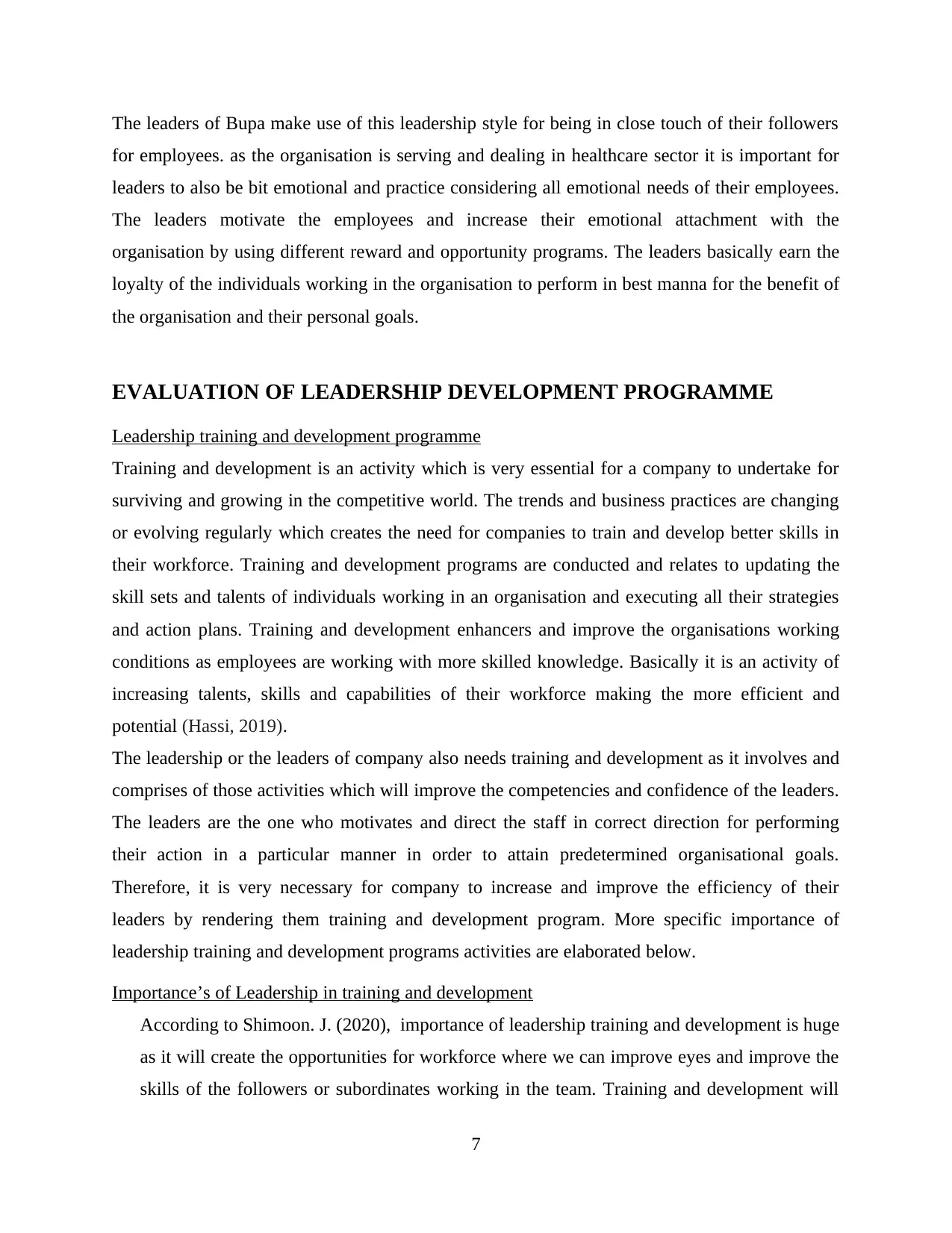
The leaders of Bupa make use of this leadership style for being in close touch of their followers
for employees. as the organisation is serving and dealing in healthcare sector it is important for
leaders to also be bit emotional and practice considering all emotional needs of their employees.
The leaders motivate the employees and increase their emotional attachment with the
organisation by using different reward and opportunity programs. The leaders basically earn the
loyalty of the individuals working in the organisation to perform in best manna for the benefit of
the organisation and their personal goals.
EVALUATION OF LEADERSHIP DEVELOPMENT PROGRAMME
Leadership training and development programme
Training and development is an activity which is very essential for a company to undertake for
surviving and growing in the competitive world. The trends and business practices are changing
or evolving regularly which creates the need for companies to train and develop better skills in
their workforce. Training and development programs are conducted and relates to updating the
skill sets and talents of individuals working in an organisation and executing all their strategies
and action plans. Training and development enhancers and improve the organisations working
conditions as employees are working with more skilled knowledge. Basically it is an activity of
increasing talents, skills and capabilities of their workforce making the more efficient and
potential (Hassi, 2019).
The leadership or the leaders of company also needs training and development as it involves and
comprises of those activities which will improve the competencies and confidence of the leaders.
The leaders are the one who motivates and direct the staff in correct direction for performing
their action in a particular manner in order to attain predetermined organisational goals.
Therefore, it is very necessary for company to increase and improve the efficiency of their
leaders by rendering them training and development program. More specific importance of
leadership training and development programs activities are elaborated below.
Importance’s of Leadership in training and development
According to Shimoon. J. (2020), importance of leadership training and development is huge
as it will create the opportunities for workforce where we can improve eyes and improve the
skills of the followers or subordinates working in the team. Training and development will
7
for employees. as the organisation is serving and dealing in healthcare sector it is important for
leaders to also be bit emotional and practice considering all emotional needs of their employees.
The leaders motivate the employees and increase their emotional attachment with the
organisation by using different reward and opportunity programs. The leaders basically earn the
loyalty of the individuals working in the organisation to perform in best manna for the benefit of
the organisation and their personal goals.
EVALUATION OF LEADERSHIP DEVELOPMENT PROGRAMME
Leadership training and development programme
Training and development is an activity which is very essential for a company to undertake for
surviving and growing in the competitive world. The trends and business practices are changing
or evolving regularly which creates the need for companies to train and develop better skills in
their workforce. Training and development programs are conducted and relates to updating the
skill sets and talents of individuals working in an organisation and executing all their strategies
and action plans. Training and development enhancers and improve the organisations working
conditions as employees are working with more skilled knowledge. Basically it is an activity of
increasing talents, skills and capabilities of their workforce making the more efficient and
potential (Hassi, 2019).
The leadership or the leaders of company also needs training and development as it involves and
comprises of those activities which will improve the competencies and confidence of the leaders.
The leaders are the one who motivates and direct the staff in correct direction for performing
their action in a particular manner in order to attain predetermined organisational goals.
Therefore, it is very necessary for company to increase and improve the efficiency of their
leaders by rendering them training and development program. More specific importance of
leadership training and development programs activities are elaborated below.
Importance’s of Leadership in training and development
According to Shimoon. J. (2020), importance of leadership training and development is huge
as it will create the opportunities for workforce where we can improve eyes and improve the
skills of the followers or subordinates working in the team. Training and development will
7
Paraphrase This Document
Need a fresh take? Get an instant paraphrase of this document with our AI Paraphraser
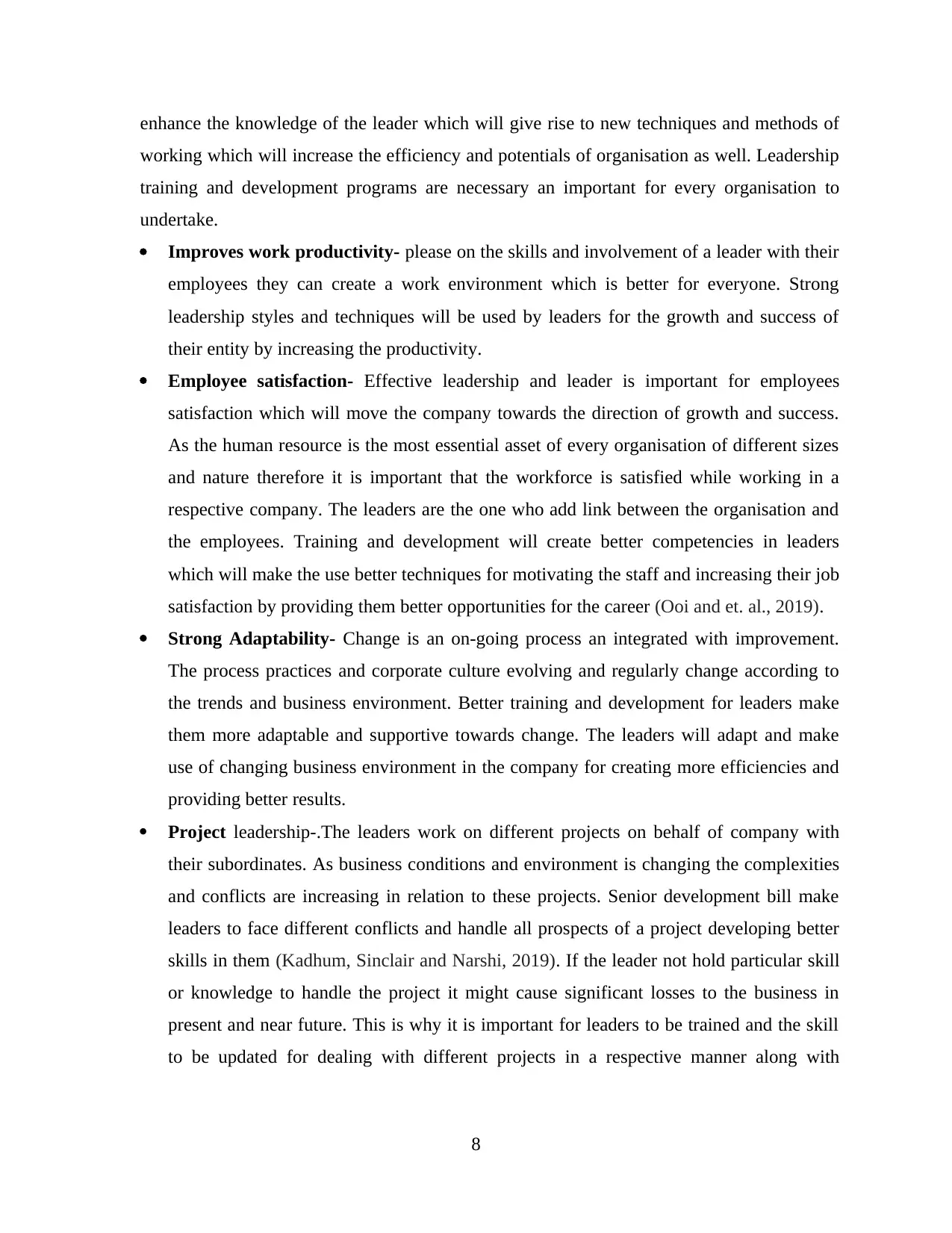
enhance the knowledge of the leader which will give rise to new techniques and methods of
working which will increase the efficiency and potentials of organisation as well. Leadership
training and development programs are necessary an important for every organisation to
undertake.
Improves work productivity- please on the skills and involvement of a leader with their
employees they can create a work environment which is better for everyone. Strong
leadership styles and techniques will be used by leaders for the growth and success of
their entity by increasing the productivity.
Employee satisfaction- Effective leadership and leader is important for employees
satisfaction which will move the company towards the direction of growth and success.
As the human resource is the most essential asset of every organisation of different sizes
and nature therefore it is important that the workforce is satisfied while working in a
respective company. The leaders are the one who add link between the organisation and
the employees. Training and development will create better competencies in leaders
which will make the use better techniques for motivating the staff and increasing their job
satisfaction by providing them better opportunities for the career (Ooi and et. al., 2019).
Strong Adaptability- Change is an on-going process an integrated with improvement.
The process practices and corporate culture evolving and regularly change according to
the trends and business environment. Better training and development for leaders make
them more adaptable and supportive towards change. The leaders will adapt and make
use of changing business environment in the company for creating more efficiencies and
providing better results.
Project leadership-.The leaders work on different projects on behalf of company with
their subordinates. As business conditions and environment is changing the complexities
and conflicts are increasing in relation to these projects. Senior development bill make
leaders to face different conflicts and handle all prospects of a project developing better
skills in them (Kadhum, Sinclair and Narshi, 2019). If the leader not hold particular skill
or knowledge to handle the project it might cause significant losses to the business in
present and near future. This is why it is important for leaders to be trained and the skill
to be updated for dealing with different projects in a respective manner along with
8
working which will increase the efficiency and potentials of organisation as well. Leadership
training and development programs are necessary an important for every organisation to
undertake.
Improves work productivity- please on the skills and involvement of a leader with their
employees they can create a work environment which is better for everyone. Strong
leadership styles and techniques will be used by leaders for the growth and success of
their entity by increasing the productivity.
Employee satisfaction- Effective leadership and leader is important for employees
satisfaction which will move the company towards the direction of growth and success.
As the human resource is the most essential asset of every organisation of different sizes
and nature therefore it is important that the workforce is satisfied while working in a
respective company. The leaders are the one who add link between the organisation and
the employees. Training and development will create better competencies in leaders
which will make the use better techniques for motivating the staff and increasing their job
satisfaction by providing them better opportunities for the career (Ooi and et. al., 2019).
Strong Adaptability- Change is an on-going process an integrated with improvement.
The process practices and corporate culture evolving and regularly change according to
the trends and business environment. Better training and development for leaders make
them more adaptable and supportive towards change. The leaders will adapt and make
use of changing business environment in the company for creating more efficiencies and
providing better results.
Project leadership-.The leaders work on different projects on behalf of company with
their subordinates. As business conditions and environment is changing the complexities
and conflicts are increasing in relation to these projects. Senior development bill make
leaders to face different conflicts and handle all prospects of a project developing better
skills in them (Kadhum, Sinclair and Narshi, 2019). If the leader not hold particular skill
or knowledge to handle the project it might cause significant losses to the business in
present and near future. This is why it is important for leaders to be trained and the skill
to be updated for dealing with different projects in a respective manner along with
8
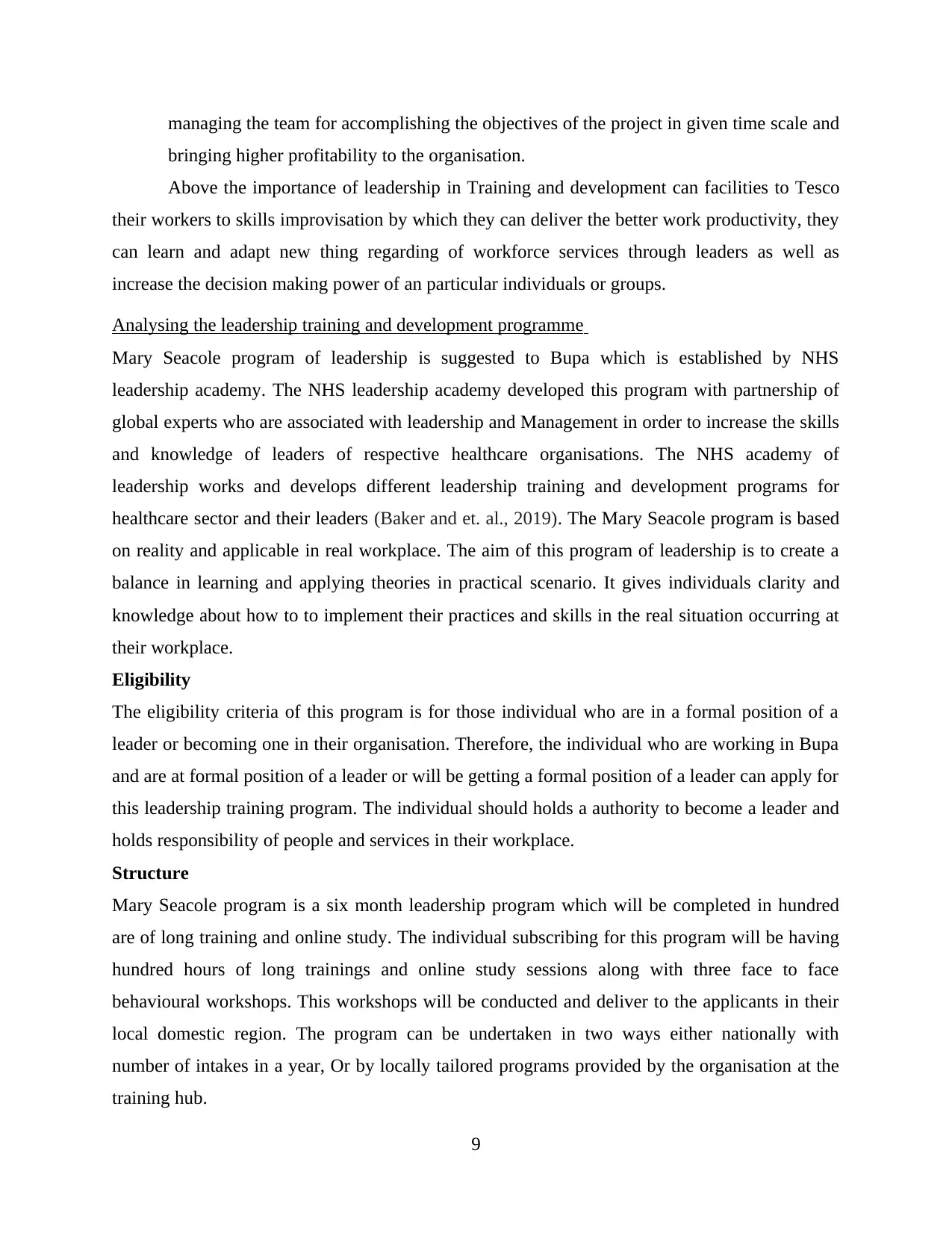
managing the team for accomplishing the objectives of the project in given time scale and
bringing higher profitability to the organisation.
Above the importance of leadership in Training and development can facilities to Tesco
their workers to skills improvisation by which they can deliver the better work productivity, they
can learn and adapt new thing regarding of workforce services through leaders as well as
increase the decision making power of an particular individuals or groups.
Analysing the leadership training and development programme
Mary Seacole program of leadership is suggested to Bupa which is established by NHS
leadership academy. The NHS leadership academy developed this program with partnership of
global experts who are associated with leadership and Management in order to increase the skills
and knowledge of leaders of respective healthcare organisations. The NHS academy of
leadership works and develops different leadership training and development programs for
healthcare sector and their leaders (Baker and et. al., 2019). The Mary Seacole program is based
on reality and applicable in real workplace. The aim of this program of leadership is to create a
balance in learning and applying theories in practical scenario. It gives individuals clarity and
knowledge about how to to implement their practices and skills in the real situation occurring at
their workplace.
Eligibility
The eligibility criteria of this program is for those individual who are in a formal position of a
leader or becoming one in their organisation. Therefore, the individual who are working in Bupa
and are at formal position of a leader or will be getting a formal position of a leader can apply for
this leadership training program. The individual should holds a authority to become a leader and
holds responsibility of people and services in their workplace.
Structure
Mary Seacole program is a six month leadership program which will be completed in hundred
are of long training and online study. The individual subscribing for this program will be having
hundred hours of long trainings and online study sessions along with three face to face
behavioural workshops. This workshops will be conducted and deliver to the applicants in their
local domestic region. The program can be undertaken in two ways either nationally with
number of intakes in a year, Or by locally tailored programs provided by the organisation at the
training hub.
9
bringing higher profitability to the organisation.
Above the importance of leadership in Training and development can facilities to Tesco
their workers to skills improvisation by which they can deliver the better work productivity, they
can learn and adapt new thing regarding of workforce services through leaders as well as
increase the decision making power of an particular individuals or groups.
Analysing the leadership training and development programme
Mary Seacole program of leadership is suggested to Bupa which is established by NHS
leadership academy. The NHS leadership academy developed this program with partnership of
global experts who are associated with leadership and Management in order to increase the skills
and knowledge of leaders of respective healthcare organisations. The NHS academy of
leadership works and develops different leadership training and development programs for
healthcare sector and their leaders (Baker and et. al., 2019). The Mary Seacole program is based
on reality and applicable in real workplace. The aim of this program of leadership is to create a
balance in learning and applying theories in practical scenario. It gives individuals clarity and
knowledge about how to to implement their practices and skills in the real situation occurring at
their workplace.
Eligibility
The eligibility criteria of this program is for those individual who are in a formal position of a
leader or becoming one in their organisation. Therefore, the individual who are working in Bupa
and are at formal position of a leader or will be getting a formal position of a leader can apply for
this leadership training program. The individual should holds a authority to become a leader and
holds responsibility of people and services in their workplace.
Structure
Mary Seacole program is a six month leadership program which will be completed in hundred
are of long training and online study. The individual subscribing for this program will be having
hundred hours of long trainings and online study sessions along with three face to face
behavioural workshops. This workshops will be conducted and deliver to the applicants in their
local domestic region. The program can be undertaken in two ways either nationally with
number of intakes in a year, Or by locally tailored programs provided by the organisation at the
training hub.
9
⊘ This is a preview!⊘
Do you want full access?
Subscribe today to unlock all pages.

Trusted by 1+ million students worldwide
1 out of 17
Related Documents
Your All-in-One AI-Powered Toolkit for Academic Success.
+13062052269
info@desklib.com
Available 24*7 on WhatsApp / Email
![[object Object]](/_next/static/media/star-bottom.7253800d.svg)
Unlock your academic potential
Copyright © 2020–2025 A2Z Services. All Rights Reserved. Developed and managed by ZUCOL.





